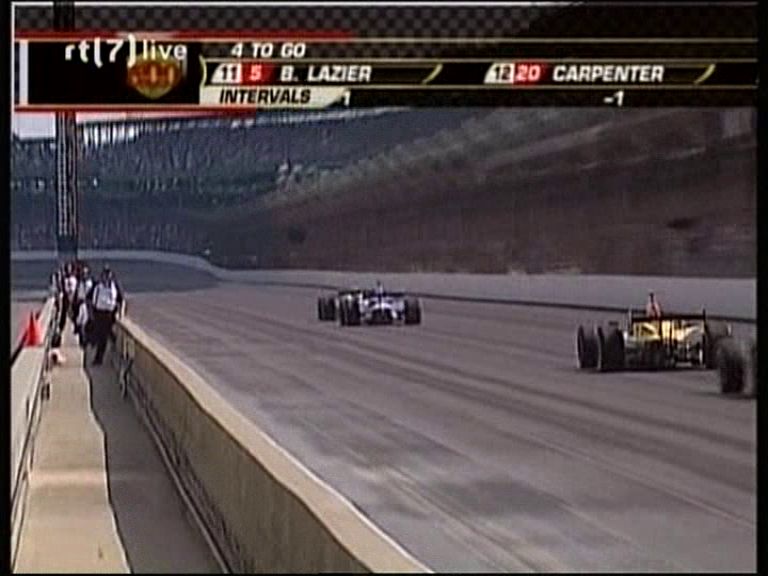Theo Verelst Local Diary Page 34
The same holds as for my tripod and
other diary pages: nothing on this page may be copied or changed and
distributed except that the page as a whole may be printed or otherwise
transferred in unchanged form, mentioning the original URL
and global page reference, and that holds for everyone on the globe
and beyond, including so called 'christians' and self-appointed 'Secret
Services'.
Sun may 28 19:38, 2006
Done with the previous diary page and still standing? I
don't want to knock people of their feet, but because of the complete
lack of interested people to make a normal or better difference in my
life to go somewhere where I wanted or to lets say make sure I'm being
asked overseas or God knows what reasonable possibilities should be
open, I have the purpose of not understating my own capabilities,
simply because modesty would probably give certain people a handle to
try to call me crazy after all.
I sometimes feel in this country as if the invasion of the
bodysnatchers has taken place instead of the revelations of the
enlightened boys of their mothers like the New Age motherf*s will have
us all believe.
I wrote the introduction above at the time indicated but I lately tend
to take longer than a few days to work on a diary page, which is not
listing all my activities, and certainly not all my thoughts, though
most stories and thoughts are relevant to know something about me.
Girlish, maybe ? No, its somewhere between a laboratory journal as
professional hobbyist and 'Dear Diary' in a magazine, and a
professional public news-blog and an intelligent internet chat for one
person. The most of this page is written later, this the day after
T-monday.
T-Day
That's because last monday I did a short presentation at the AES
meeting at Phillips eindhoven about some of my audio related work,
I could easily load the web page with
the information and pictures during the lecture sequence from my
server on the presentation notebook with beamer, though it had no audio.
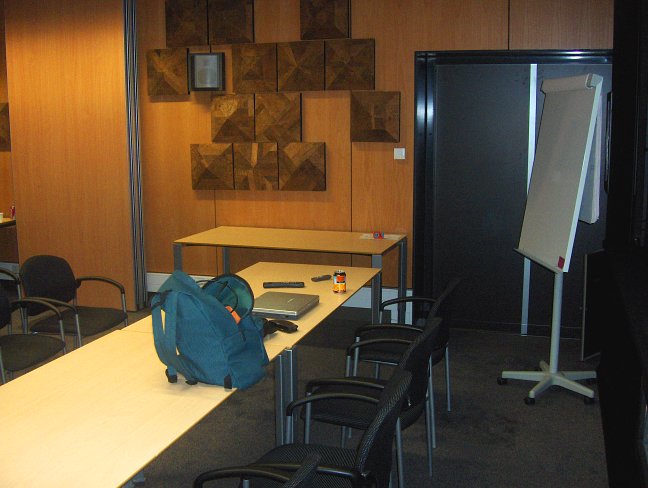
After everybody had left
I decided to make a picture of the surround presentation room
The succesfull DA converter had been put in the bag already in the
above picture, and the audience out to diner, only a side speaker of
the surround sound system is visible. It was supposed to have cost
about 25 thousand euros, but I wouldn't give it that, it sounded a bit
weak, fuzzy, maybe had sampling issues, but I don't know for sure, high
range was a bit weak, subwoofer very limited in appeal, though there
was low end. As often is the case with the say 20 cm diameter speakers
popular in certain types of expensive hifi systems (also where pipes
are popular), the midrange sounds compressed and not very lively.
Well, I got an input to the system, just stereo, and the recording (16 bit stereo 44.1 wav) I
made only the same morning before I got on the train (no more car...)
sounded apart from notably noisy because the battery powered usb
appearently has a too low voltage for the AD converter to feel happy
about converting with its normal dynamic range, quite well in spite of
being a recording from the DSP board analog output
(form the 24 bit 48KS/s DA converter).
I know the sound of the synth and the DA converer, which is quite quite
neutral in many ways, including unprocessed, straight microphone
recordings and reproductions which works good, from at least three
different speaker systems and a Sennheiser headphone as reference too,
and of course the recording sounded good, but also as I wrote above. It
seemed also that the normal 0dBm or so output voltage of the DA
converter wasn't enough to really make a good volume, and there was
clear (notebook) switched supply or grounding noise noticable in the
surround amplification, that should be preventable for a profi system!
First, a song. That hardly anybody can learn.
Well lets start that long time line of thought with songs many people
know the originals from, like "Message in a bottle" and "mamma mia", of
which I did some short renderings in a very short
recording/multitracking time (hour or so), mainly to communicate about
the difference of taking a compressor and chorus unit and some lame
drum samples and some audio processing tool and making music.
The wav files are 44.1 KS/s / 16 bit stereo (full normal CD quality),
and therefore big.
Message in a Bottle
(originally from The Police)
compressionon drums
and a bit of plugin reverb on drum and brass (26.6 Mega Byte, wav)
mp3
(256kbps) mp3
(48kbps)
the same + tv
reverb and track mix compression. (26.6 MByte, wav)
mp4
(256kbps) mp3 (48kbps)
mamma mia with electric guitar
(14.8 MByte, wav)
ape (50% compared to wav)
mp4 (256kbps) mp3 (48kbps)
synthesizer disco experiment
(16.5 MB, wav)
ape (50% of wav) mp4 (256kbps) mp3 (256kbps)
Format legenda:
ape
|
lossless compression format,
available for winamp, about 50% reduction for most stereo wav files.
|
mp3
|
the well known mpeg-3 audio
format. available for most modern players.
|
mp4
|
aac (newer than mp3) audio
coding, bit better quality or lower bandwidth then mp3 sound mplayer,
recent winamp, recent quicktime player can play these, possibly windows
media player if you have the codec.
|
I was reading an article
in Sound On Sound magazine which describes "Recording a String
Section" with expensive enough equipment, various microphones and
mic setups and there is an accompaying internet page with short recording
examples in mpeg format.
I've used
I've seem him in holland, but I found this dvd from Mike Stern Live (New Morning, Paris)
where he plays with mr Chambers (drums):
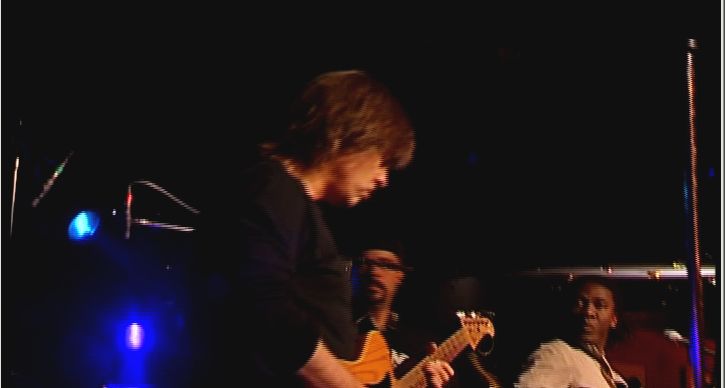
A short sample from the DVD in mpeg-4 format,
30 seconds of the beginning, with mpeg4 (Quicktime for Linux) video
(29.97fps, yuv420p, 720x480) and Aac encoded audio (44.1 kHz stereo
coming from main stereo stream), resp. at 700kb/s and 256 kb/s,
totalling a bandwidth this server can serve in realtime if your adsl is
up to it and there is no contention..
Happy viewing! Not many artifacts or coder trick abuse here, and quite
acceptable sound, so as internet viewing goes, this is more than quite
bearable. I could play the file (right click to download) with mplayer (linux or windows XP)
Quicktime Movie player (on XP it gave a warning but it works fine), the
video with an old microsoft media player and the audio with winamp.
The commands to create the above were:
mplayer -dumpvideo -dumpfile /Video/stern.dumpvid dvd://1
ffmpeg -i /Video/stern.dumpvid -t 30 -deinterlace -b 3000 /Video/stern_k.mp4
ffmpeg -i /Video/stern_3k.mp4 -i /Video/stern1.wav -b 700 -ab 256 -vcodec mpeg4 -g 300 -bf 2 /Video/stern1.mp4
The stern1.wav file I made by playing the (officially purchased) DVD
with mplayer in a XP machine, starting up Nero Waveeditor and adjusting
the audio and record and level settings such that I could capture the
played audio in a wav file, and recorded a minute with wabeeditor from
the windows audio bus (better would be over an optical link).
Some pictures, maybe ?
This picture is from france, after some processing::
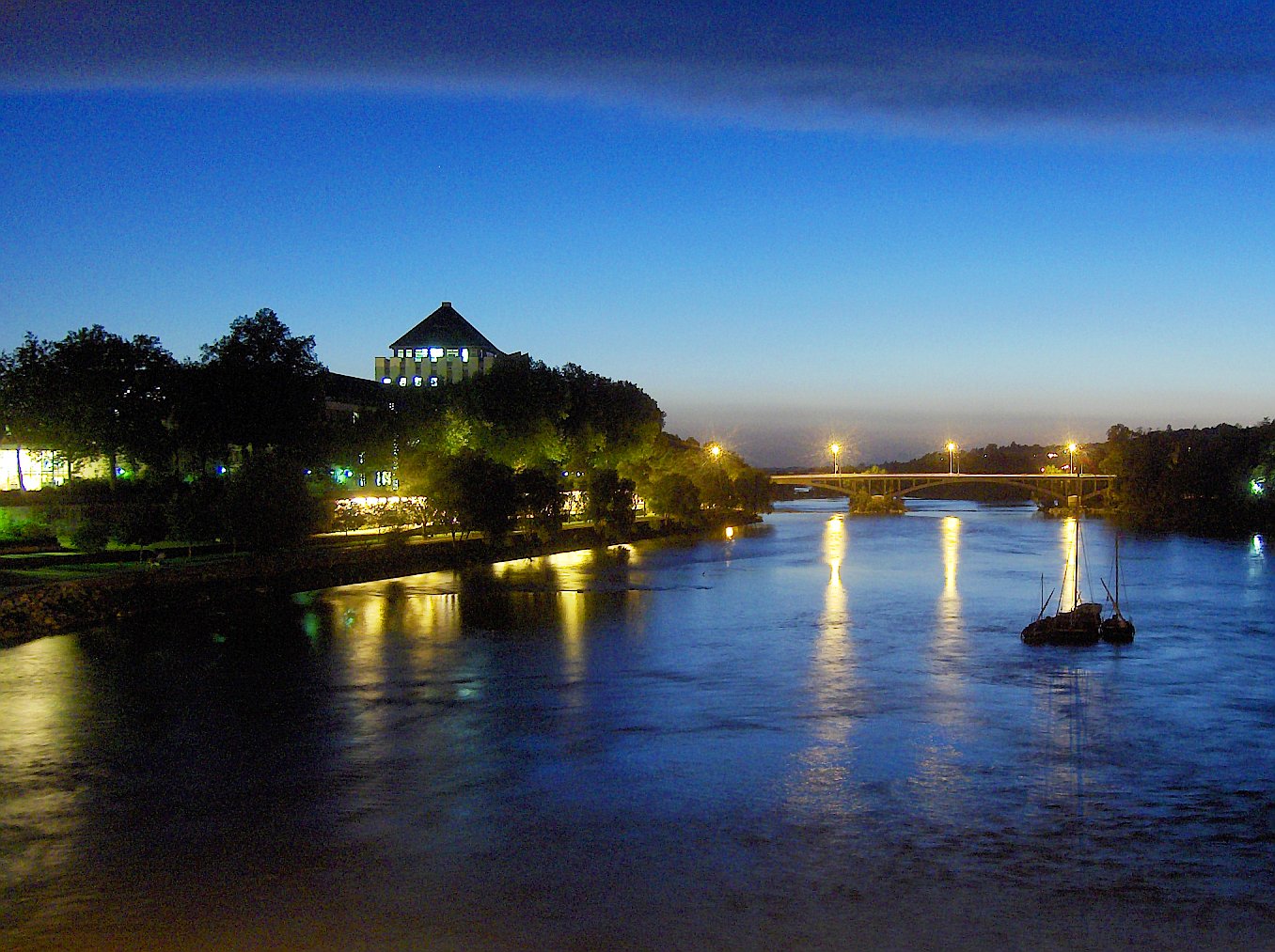
The big size is for people with bigger screen sizes for their browsers.
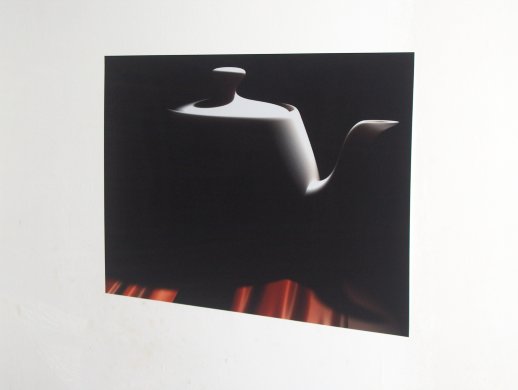
This is a quick sideway photo from a (photo paper, 75x50) printed
graphics work, which is
shown below (under 3D programs) . Another recent picture:
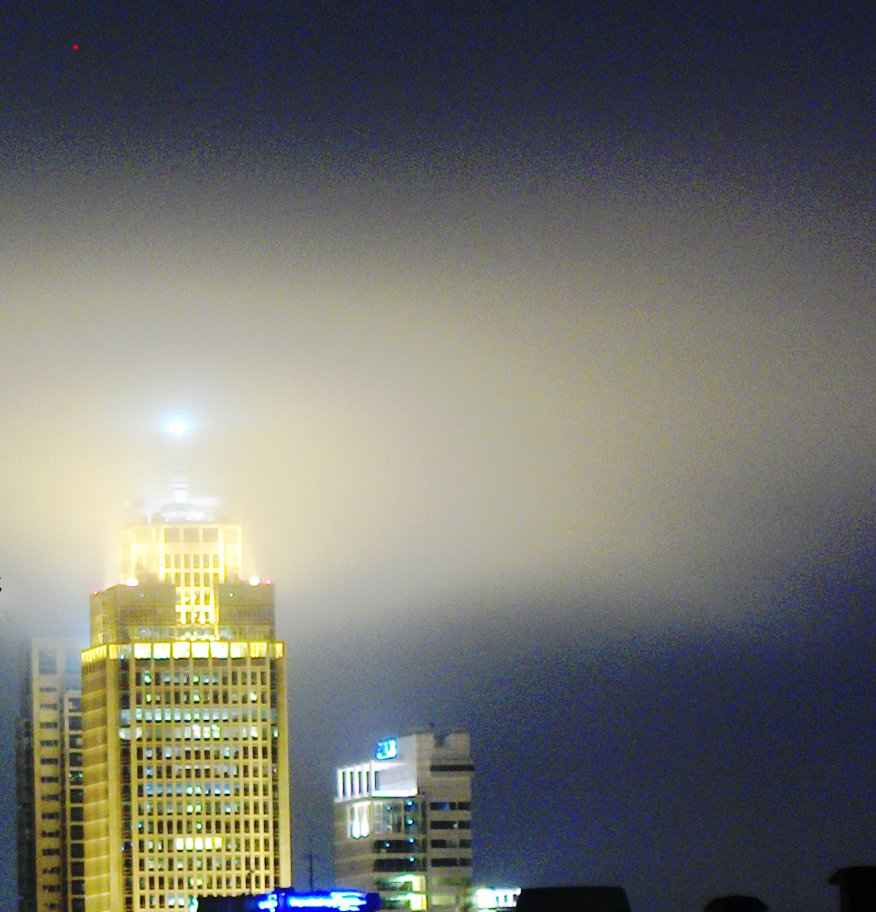
Its the view of the Philips management tower in amsterdam (with a zoom).
I'm reading the latest (I got it a week or so after it came out!) John
Sandford, which after a few years developed into New York times top
selling auhtor, called "Dead watch":
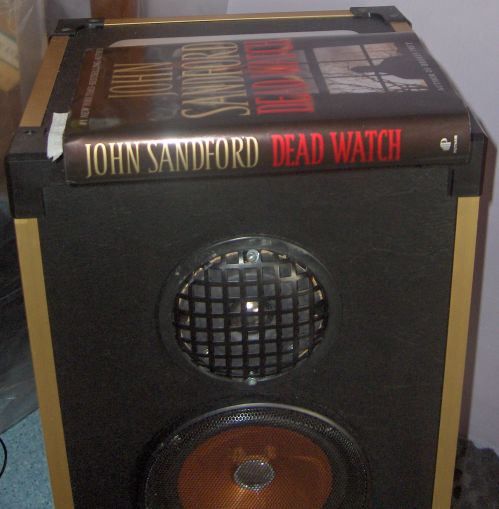
HiFi from 1959
!
From just before the sixties, these are scans from handbook for
electronicists (I had one at home when I was a kid) full of worthy and
relevant and fairly hard electronics information from the time that
stereo was still a rarity:

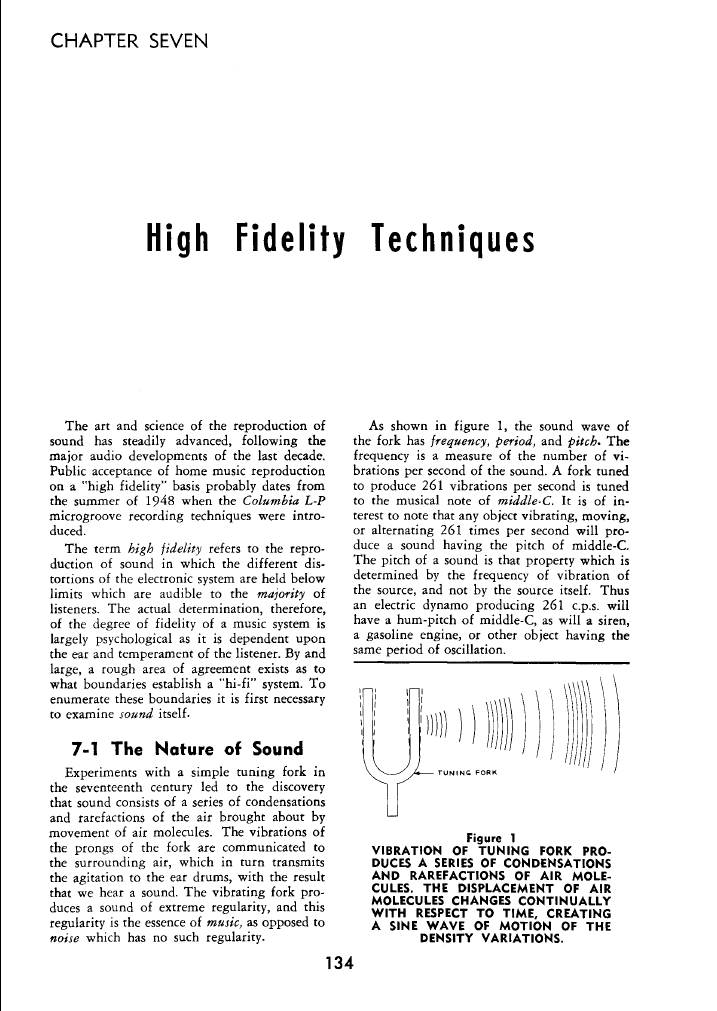
Yep, an old term already "HiFi".
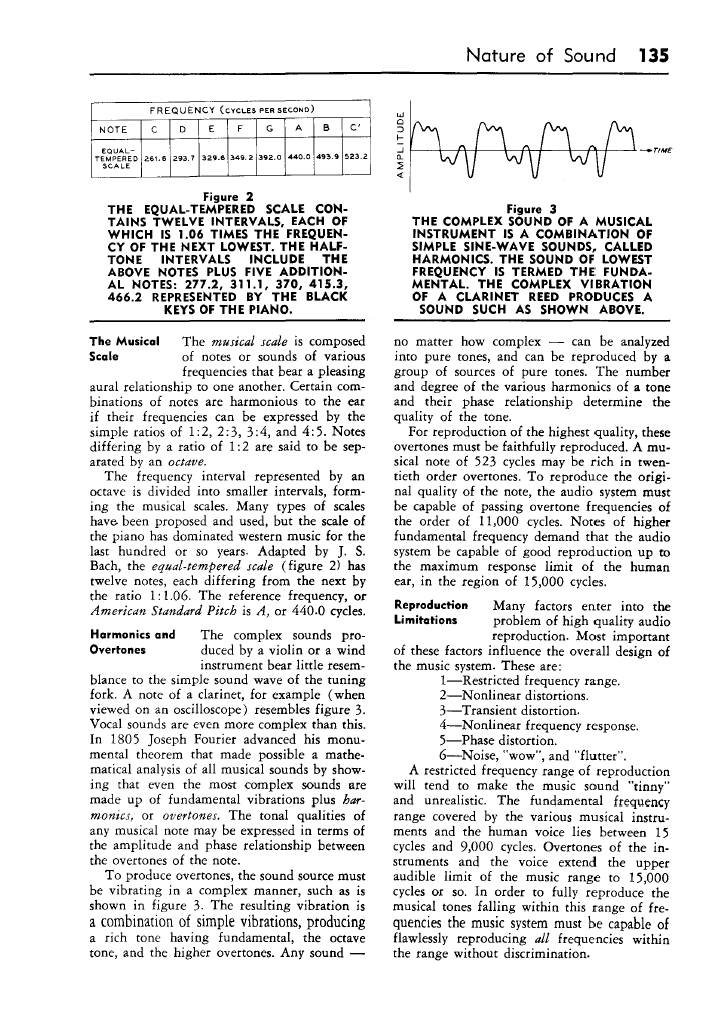
The HiFi official norms!!!
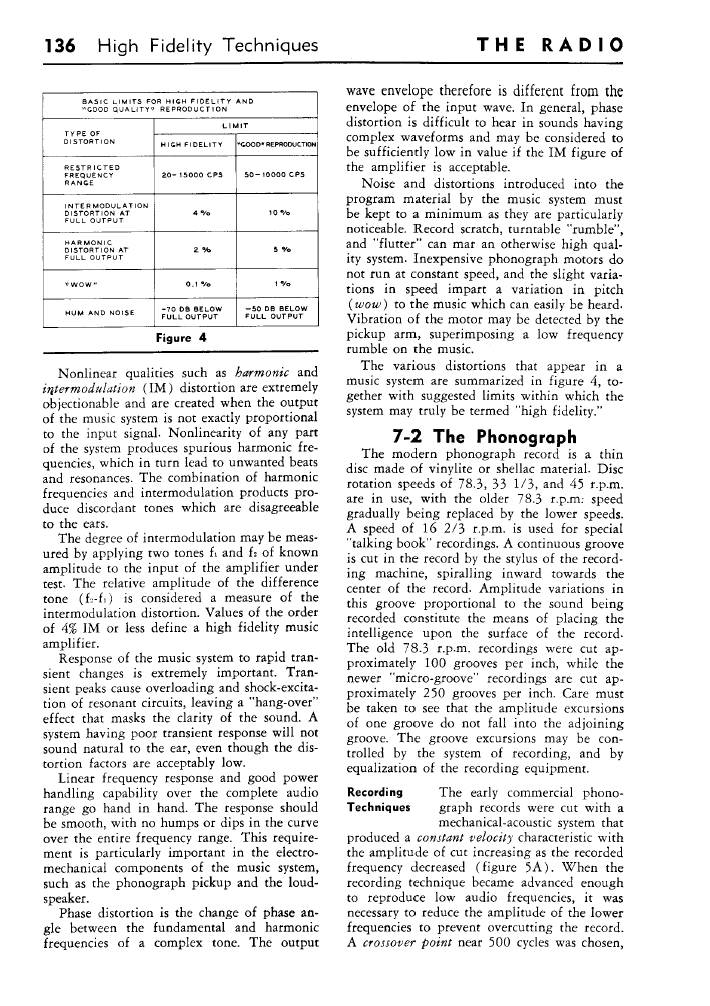
I recall that as a kid (in te 70s, lucky me) I wondered wether
equipment I listened to or even could use for myself would actually be
up to the official "HiFi" norm.
not so many years later, I knew I had built and owned equipment which
was certainly a lot better than the at the time for ridiculous norms
for the frequency range and distortion, excpet for speakers....
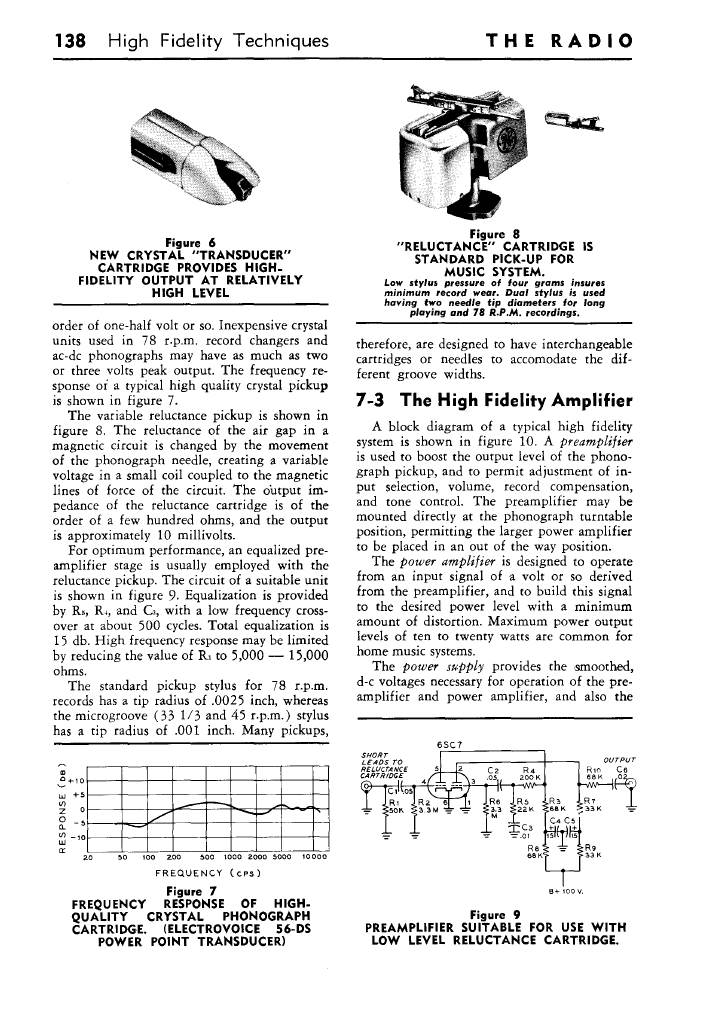
Well, quality and High Fidelity (closeness to the original) are terms
which I use for my equipment, but they go way back was we see proven
here!
Pedofile Fascists
Ouch, thats a miserable expression.
Like "bloody Nazi" or "Schweinhund" or "motherf*ing liar" or "Platonist
Demagog", "Childabusing Schizofrenic", "Dr Jackhal" or what have we,
dictionaries full of swearwords, I'm sure for every language there is
an internet list of swearwords for many swearing occasions.
I tend to want to write such that these pages will not be sufficiently
offensive to be somehow banned from real or fake 'neat' loving people.
The title of this section is composed of decent scientific
terminology which however gives me the creeps, too.
I remember seeing those Nazi time movies on Discovery Channel, or maybe
National Geographics, where for instance naked or strangely half-mature
looking
I remember an argument in the student house I lived in about adultness
coming from catholic side, where a fresh woman/girl was simply
rendered mature enough to be not respected.
The way I used to think about childabuse is more general than
pedofiles, and of course on one hand the pedofile social or sexual
abuse is more severe and on the other hand, the pedofile is supposed to
lets say be "in love" in some horrible way with a child.
That "in love" idea is where 1984-like games find place I think, where
"programs" have to be invented to "teach" young, small, impressionable
and fragile kids to stay quiet, be impressed or so and under control,
and all the evils they want them to learn.
I had a nephew come and stay with me in the Hague when I was little boy
(like in the 70s) which I suspect might have been in touch with
pedofiles when I think back on the way we talked and played. My own
'dad' may have had mean pedofile intentions, I should rethink a lot of
things to make my mind up, but I'm sure that in normal interpretation I
wasn't taking part in any sexual abuse (being that is).
I am not a pedofile, I'm sure I don't need a Pedofile Anomymous.
That is a valid thought, not just a joke, in either explanation. When I
took distance from university people I though might be evil, in the
news (in holland and belgium) there was talk of pedofiles, and there
was a book out called "children don't like crocodiles" (in dutch
"kinderen houden niet van krokodillen" (for google) and maybe french)
to draw attention to the problem which was in the context of the
dreadfull dutroux killing of children in a underground basement.
The answer I've heard to the pedofile abusers in that time (around
1995) was that the people who would be found guilty of crimes in the
area should be corrected in their behaviour by getting the chance to
have their psychogical problems worked on, lets say therapy, and not
death row or very heavy punishment. For persons who have abused
children that sounds horrible to me, I don't think that in general such
people should be tolerated much, I can imagine the sheer number of
problems in this area makes one think that solving is better than
punishing.
The hip hop guys and gals don't seem to be all too free from pedofile
thinking, thats a big group, which is miserable. I guess people from
pedofile families have trouble with certain normal behaviour and tend
to think pedofile patterns of reasoning are ok, that doesn't mean being
a pedofile, but
possibly heaving been hurt or abused or used to people with such
thoughts.
From Google Video, I've learned that there is most likely a whole
network of pedofile rich/influencial people wanting to have power I
guess to keep themselves from exposure and legal action. See for
yourself for instance:
info error
From Senator John Decamp:
In mid-1993, after The Franklin Cover-Up had been
circulating for almost a year, the British-based TV-station,
Yorkshire Television, sent a top-notch team to Nebraska to launch its
own investigation of the Franklin case. Yorkshire had a contract with
the Discovery Channel to produce a documentary on the case for American
television.
Finally, the big
day came. Their documentary was to air nation-wide on
the Discovery Channel on May 3, 1994. It was advertised in the TV Guide
and in newspapers for that day. But no one ever saw that program. At
the last minute, and without explanation, it was pulled from the air.
It was not shown then, and has never been broadcast anywhere since.
I have a copy of
that program, which arrived anonymously in my mail in
late 1995. When I watched this pirated copy, I could see clearly why
the program had been suppressed. Conspiracy of Silence proved, beyond
doubt, that the essential points I had stressed in the book (and more)
were all true.
That is of course a big conspiracy, a very mean and evil power which
should be dismantled and cease to exist as soon as possible, I'm sure
by far most normal people have that opinion, unless they are
blackmailed or threatened.
Dangerous to write? Well, I guess there are already occasions where I'm
a bit banned (besides other ongoings) Verelst has a constitutional
right to speak and even a (in holland) a legal duty to report crimes,
and doesn't want to be a coward. Wasn't, and isn't going to be.
Besides, who wants to defend pedofilia, lets get this over with!
See you later, alligator. In a while, crocodile. I think orcas eat
crocs, too.
Lunch in America
"Smugglepit or crapwell"
I used to have a good reverb when that was still relatively new, a
Yamaha REV-7 which around '85 cost me about $1300 as a sale from my
most used musical instrument supplier (mostly on my dads account at the
time, though I had study financing and I worked various jobs) they
recommended the machine as expensive but a very good price for a
professional machine, and I knew both so I went for it and was never
sorry!
What a wealth and rich warm sound suddenly filled my tiny room setup!
Great.
I learned from books or magazines or maybe from television courses that
reverb is always too much in a mix unless it has been adjusted to the
lowest level still acceptable for the producer, so always adjust the
effect return (or send) for the reverb unit as low as jou think it
still works for the song, that's usually the best.
For effects, that's not necessarily true so a heavy gated reverb on the
snare drum, or a surround effect with a quality reverb are different
cases, as is a tapped delay on a synth or guitar (or flute...) solo,
ten the effect, like with chorus, is fine when the volume of the reverb
is the same as the original in the mix.
Thats good information, for free... Well, its hard enough, it's like
trying to make a commodores cover recording: almost inpossible unless
you're a skilled and good musician. So it is like watching the pros:
nice but you shouldn't try it at home or your ego would suffer.
I have given myself the assignment to make a commodore song cover which
sounds a bit like the original, except for voices! I haven't really
started yet, but I've checked out some drum sounds from the beginning
of Night Shift...
For drums, reverb settings or circumstances are important on modern
sample synthesizers it can be found possible to set volume, pan and
effect send settings per drum sound, so the bass drum can be given a
slight reverberation or cabinet effect only, the snare a heavy gated
reverb, the toms a good heavy reverb, etc. though it isn't necessarily
so that one can use more than one different reverberation effect.
As I've written on a previous local diary page I made my own Reverb
running on DSP and also on pentium computers, which is NOT open source,
and which is 4 channel, not just stereo. That reverb, when applied on a
(analog) signal from my USB DA converter, and mixed in on the main
stereo and a rear amplification comprised of the two powered bi-amped
monitors sounds extremely good as surround reverb, expecially now the
main speakers have been phase corrected and the main mid-highs
sperately amplified.
5.1 or quadro ?
In the 70s when I grew up and had quite an interest in audio like the
major status symbols like HiFi equipment, speakers, good music and
recording. Stereo was available enough, though certainly not
everywhere, but Quadro was one of the Desirable Things, which I'd
hardly experienced in practice.
It appeared there were records out with not just stereo by doing tricks
with the needle track, but 4 channels encoded into it, and equipment
which could decode those signals, and of course amplifiers with 4
channels and extra speakers.
A cinema had that at times, too, which was great.
Needless to say quadro in that time was out for me, not a chance,
probably way to expensive...
Currently we have 5.1 which is quadro + middle channel + sub-woofer
channel. Mostly hpwever, the mid-front channel appears to be taken as
scratchy sound source identifiaction trick channel, and of course one
can create a sub-woofer channel oneself by filtering the main front
signals.
In fact I make my own sub signal (12 dB/oct filter at 40 Hz) from the
mix of Front Left and Front Right, which is reproduced by a extremely
heavy 15 inch woofer, which sounds impossibly better than those vacuum
cleaner outlet like cheap bass boxes, and also the sound from the .1
channel is usually made for those cheap devices and sounds absolutely
dreadfull.
So stick with quadro, the space information in the mid-channel is not
worth trying out. A bag of bad tricks, nothing for serious audio
enthousiasts in my experience thus far (maybe I tried the wrong 5.1
sources).
I've downloaded a (paid) article from Electuur electronics magazine
about an amplifier I've studied some years ago, which interested me
because it as both very high quality and extreme power: up to a
(real...) kilowatt per channel, about the maximum that can be driven
from a normal 230 Volt outlet.

There's a german
company which sells kits for this build it yourself amplifier, they
aren't exactly cheap though, these machines.
MIT courses !
The Massachusetts Institute of
technology has a truckload of high level university courses
on te internet, for free!
I saw about it on CNN, and checked out some physics andmathematics
courses, the mathematics department has videos on, which is cool,
physics has course outlines, books, and exams and exercises with
solutions on, and remember this is one of the worlds top universities,
this is heavy material!
Davidson on the Internet!
Long ago, before things went really miserable for me, I had started to
look into the translation issues of the Old Testament of the bible, and
I had from even longer ago a lexicon from the previous century (1850)
with all the hebrew words and derivations from the old testament books.
I had tried to come up with a word translation method which would make
use of the pictorial
meaning of the hebrew letters, assuming there would be one and that
I could find the right meanings, which to an extend seemed to work, and
give me sensible translations and prevention of errors as present in
the normal main translations (see also example 1 and example 2 , rationale).
Recently I've been able to order The Analytical Chaldee and Hebrew
Lexicon from Amazon.com, and I've started scanning in the pages with
the lexicon. Here is a first
start of a web accessable set of scans. Mind that the copyright is long
gone, and the man no longer alive, so there is no problem with that !
An example column from the book:
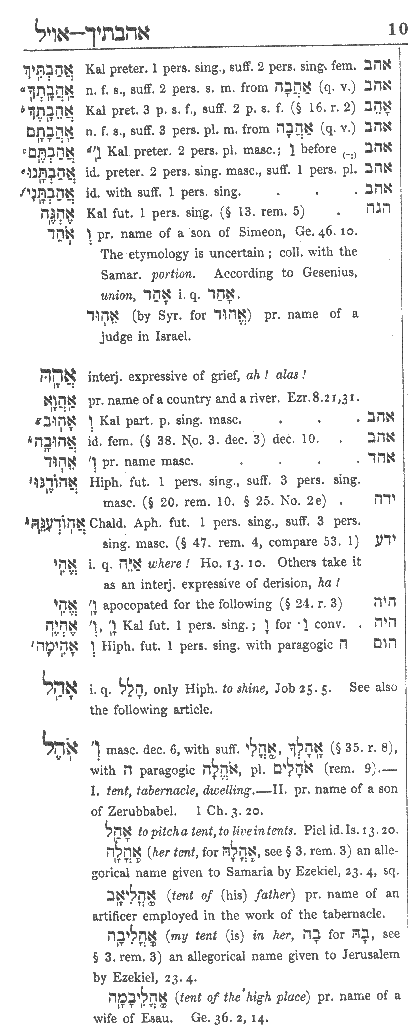
Main speaker phase linearisation
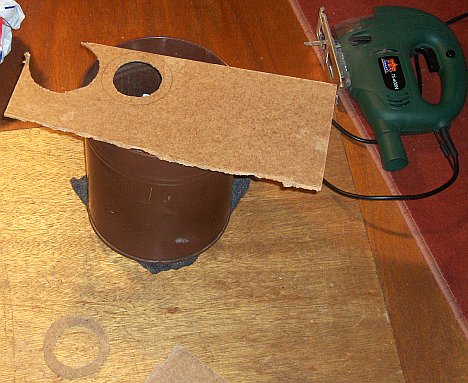
I've started the speaker upgrade with measuring the difference in
height between the middle of the dome of the hight tweeter and the
average cone depth of the mid high tweeter. I measured with a slide
gauge with respect to the flat speaker front plate and found material
to make up for the height difference by putting two layers of hardboard
behind the mid-high tweeter.
Above the 2 layers are shown being sawn out of a plate.
This is the tweeter which will be lifted:
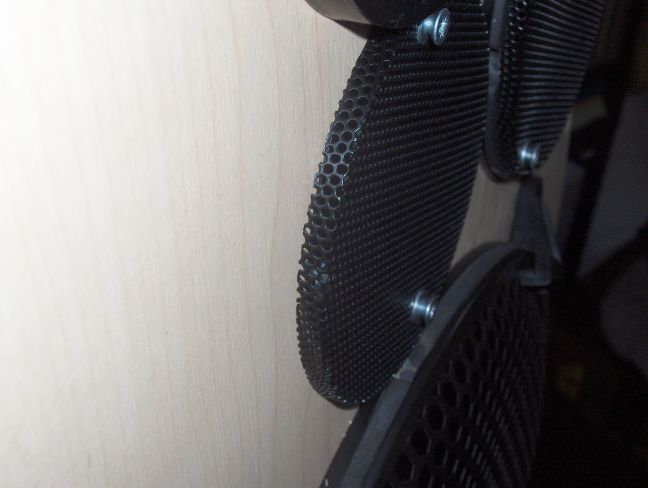
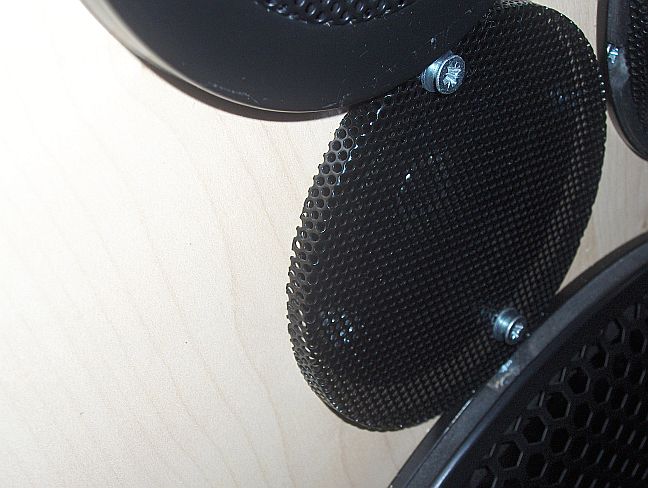
First: demontage
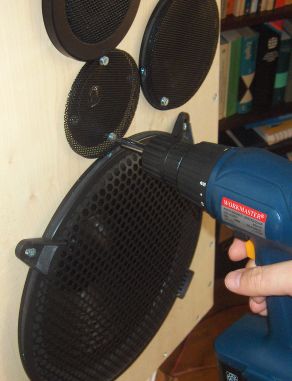
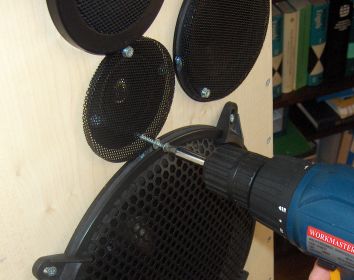
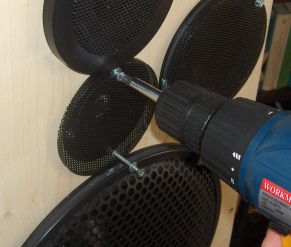
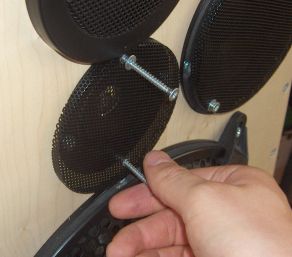
electrically descrewing the grille, and removing the grille:
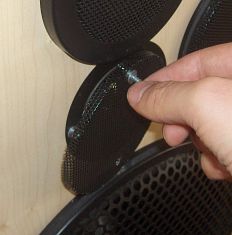

The tweeter without height adjustment, removal of the main mid-high
tweeter montage screws:

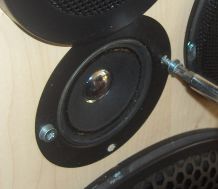


carefull not to damage the sensitive cone of deform the metal (the
tweeter is only €7.50 but it needs to be in perfect condition or
distortion will result), removal of tweeter:
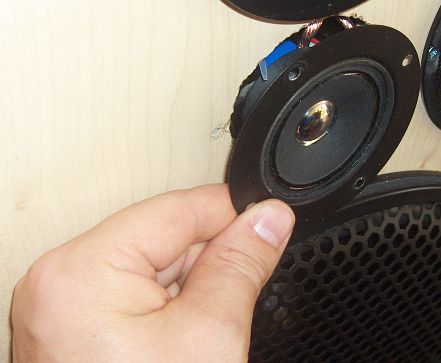
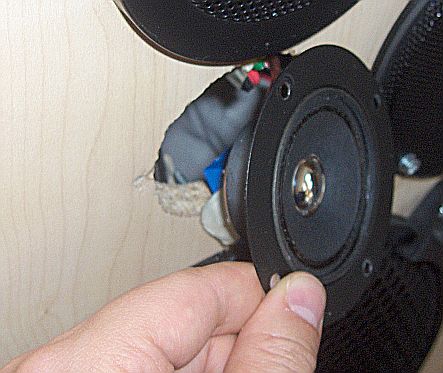
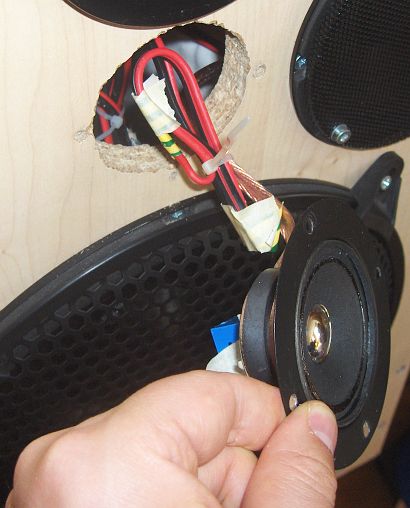
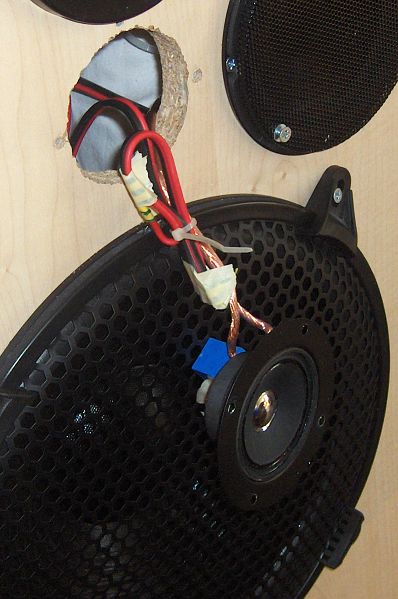
Finishing of the adapters which must fit good to prevent any
air-leakage, these pressure enclosures are quite airtight: when the
woofers are displaced it takes them over 10 (ten!) seconds to return to
neutral!
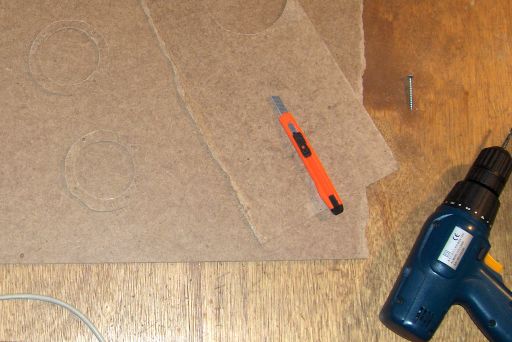
After removal of faults and unevennesses the distance rings are put in
place to test the fit on the back of the flange of the tweeter:


Now the tweeter with distance assembly which has been drilled through
for the scew holes which also have been evened is fitted in place:
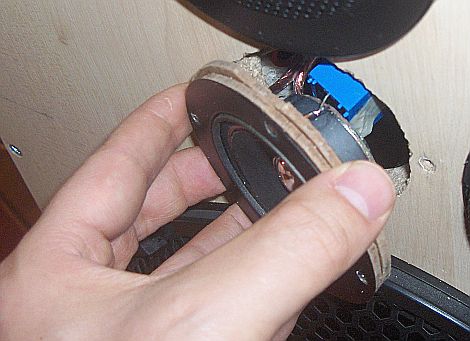
The very long and heavy standard size screws carefully back in place
with exactly the right tension, and not over pulling of the sensitive
speaker rim:
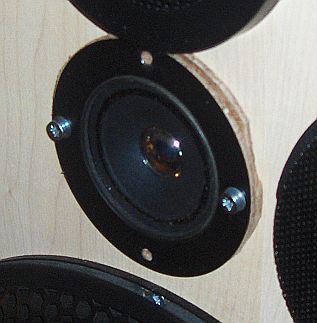
And then of course the grille back on...
What did that little change do for the sound? A lot! the definition of
the middle high tones at the normal listening position has considerably
improved, because these 7mm of phase correction correspond to a quarter
wavelength of tones of 10 kilo Herz and even more for yet higher (very
audible) tones. Th ecrossover frequency is a little under 10kHz for the
dome tweeter, so at this frequency, which is reproduced by this little
speaker, there is simulaneous sound reproduction withe the dome tweeter.
At the sweet spot of the speaker setup (which are a little bit tilted
upward and almost at head-height) the effect is a much nicer and more
open sound which I kew from previous systems had made/had should be
possible with these quality components and the good amplifier and DA
converter I use.
Main speaker bi-amplification
There was an even more audible unnormality plaguing me about the main
speakers, preventing all to accurate monitor use a bit, which is the
loudness of the mid-high cone speakers, which is a lot higher than the
other 3 speakers in the enclosure. That was very audible.
So I finally decided to make the main speakers bi-amped (though not yet
actively filtered) because of course no sensible hifi-designer can
afford to make damping figures of like 500 reduced to 2or 3 by using
passive power reduction, apart from the rather danting task of finding
a resistor which can dissipate up to a few hundred Watts of peak
power....
Basically I use another high quality (but less top power) amplifier to
drive the mid-highs at significantly lower (and adjustable) volume
keeping perfect quality and keeping good damping figures.
To make this possible I needed a sperate connection with the mid-highs
which in a air-sealed enclosure is a bit of work (everything is screwed
tight and all the edges are silicone kit sealed), but I copied the main
wire output on the back with another 2.5 square mm thick good audio
cable.
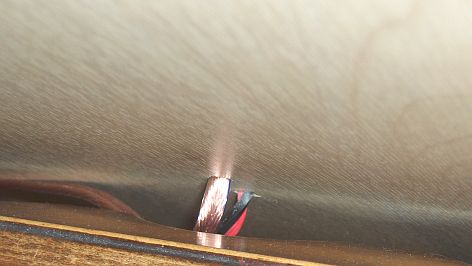
That cable is connected to another amplifier which is connected in
parallel to the main signal pre-amplifier output with the normal high
power amplifier and the inputs to the sub-low bridged amplifierm for a
total of six amplifier channels for these main monitors.
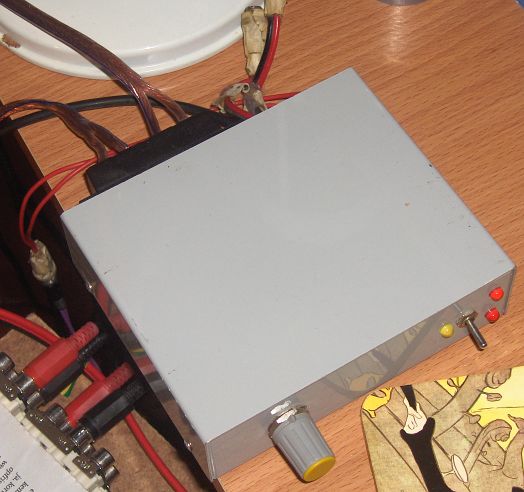
The small amplifier has more than sufficient power for the 2x20Watts
needed for the mid high tweeters with this 160 Watts toroid transformer
connected to it:
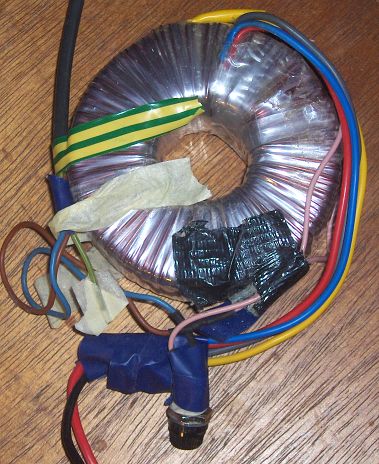
From normal sound management point of view it is fine to have the
frequency namd around the sensitive 3-4 kHz amplified with less power
than the low and sublow range, and also less than the (in this case
powerfull) tweeter, which needs to generate the loud high to very high
frequencies and transients.
The result? Thus far the speaker system sounded extremely good and
strong, with these upgrades it sounds more excellent, more even in
frequency range obviously. The songs that are well mixed or challanging
sounds even better than before already, and for instruments and mixing
the system sounds very very good now, apart from the already very
attractive quality.
Sweet and powerfull (It should be at over 500 Watts of total actual
power).
Very detailed and capable of accurate and wide and deep stereo image
and good and live-amplification like transients when asked for it while
remaining almost scary rock solid in simultaneous continuos highs and
lows.
Har har.
Cinerella
Not all good things in life are free, and not everything that's free is
good, but some good things are even free!
Cinerella is
a free and fully open source movie
edit program for primarily Linux,which allows viewing and
editing (real time) of all kinds of video formats, including mpeg and
mpeg-4 and audio, effects (audio and video) also in HD (High
Definition) format.
Absolutely marvelous!
Is it finished ? Uhm, some things don't work (yet), there are issues
like obviously speed (even a 3.3 GHZ 64 bit Athlon has its limits) but
its great to have frame for frame viewing and editing possibilities for
mpg movies working great, and quicktime/mpeg-4 for linux movie writing
is cool.
Also, it runs over the network with remote X windows, and it looks and
views great.
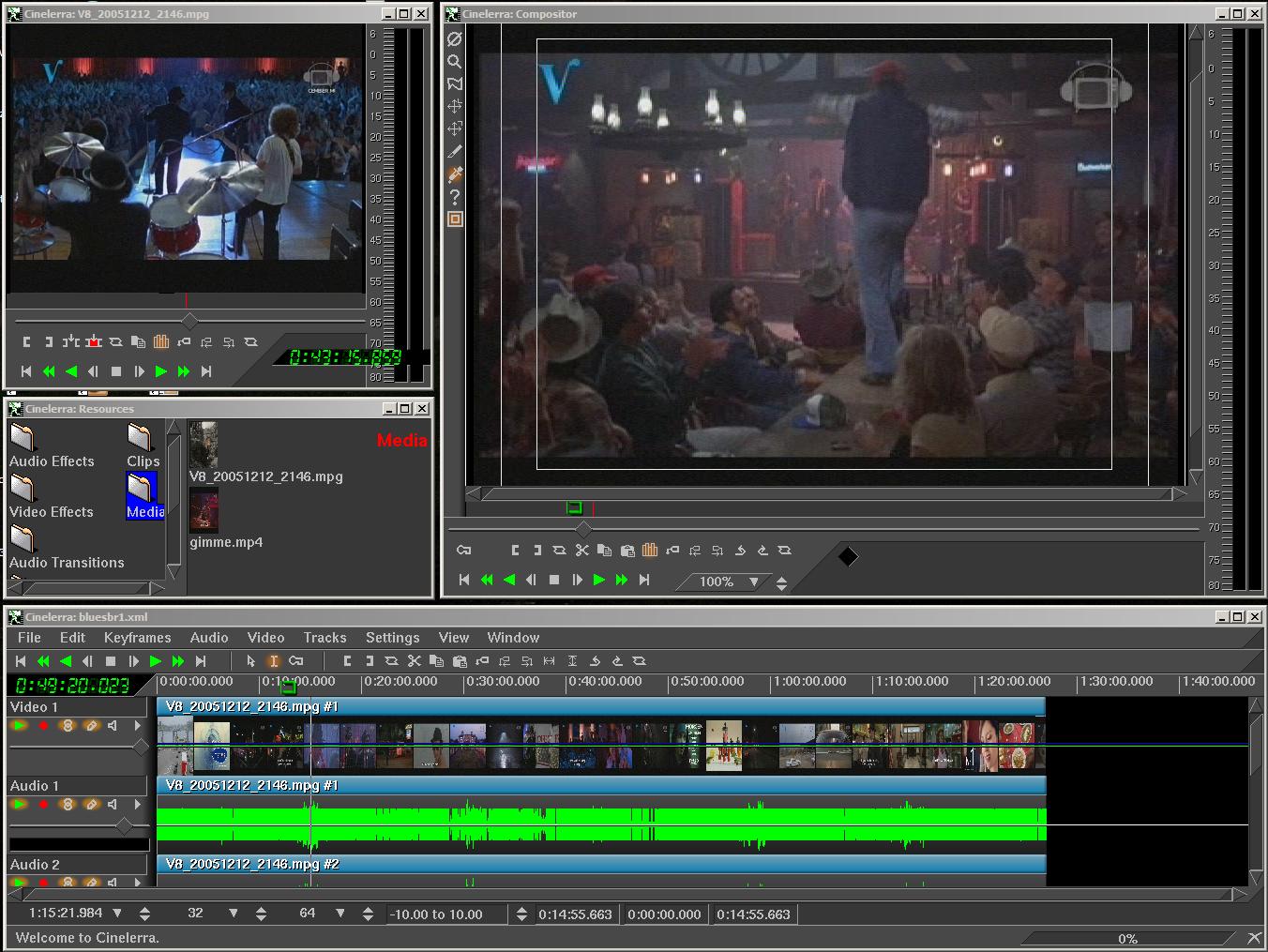
The above is a screendump of a medium large cinerella setup running on
RedHat Fedora Core 4 / 64 over a network with the display on a notebook
(which of course doesn't allow for full framerate viewing).
Alternatively, I've run E-Live, a one-CD Linux distribution which
starts from CD without requiringan isntall, which contains cinerella
(inabout this version) and which seemed to give full framerate enhanced
D1 video quality on a pentium D machine (just a pity E-Live doesn't
allow remote X windows to be shown, there must be a safety option
somewhere...)
The above screen dump is from a fedora core4/64bit version which I
compiled myself, from scratch, because to my knowledge there is no
precompiled version for this OS yet, let alone a (fedora) Yum install.
So I set down one evening, and later in the night following I had
compiled 5 or 10 external packages and their dependencies and the
cinerella package (minus the firewire support) which indeed started up!
If someone is interested in the compile/install log let me know.
This is an example still from a small sequence I made (in mp4) from a
BBC improved resolution signal (digital satellite) film containing two
version of the same mountain scene which are time shifted during the
flying camera movement and the crossfade into a map image, the mix is
made using the sliders on the left of the edit window:

This still has noise from the map and looks moderately sharp, the
sequence result looks quite sharp when played as (high bandwidth)
mp4 file.
Free / Open Source 3D Graphics
NVidia has released its Gelato rendering software to be freely
used, with some limitations (but not size or quality) with respect to
the commercial version which costs $1500 (iirc). Gelato makes use of
the NVidia graphics card of a computer to togeher with the CPU render
complicated graphics scenes in high quality, and with considerable
speed when compared to jsut about all other rendering solutions. Hurray
for NVidia!
I've made a Interactive
Gelato page which contains a small gelato rendering example program
which can be called to run from the webserser, so when you change the
(single) parameter to the cgi page, an actual gelato program (I
installed Gelato with some effort on Fedora Core 4 / 64 bit) starts
running, lets the graphics hardware of compute for you, and puts
the resulting image on a web page.
I've mentioned this in the gelato forum,
and hundreds of program runs afterward seem to indicate all works well.
This is the last image rendered by someone trying the example page:

A more profound example of the renderpower of gelato s this teapot
scene:
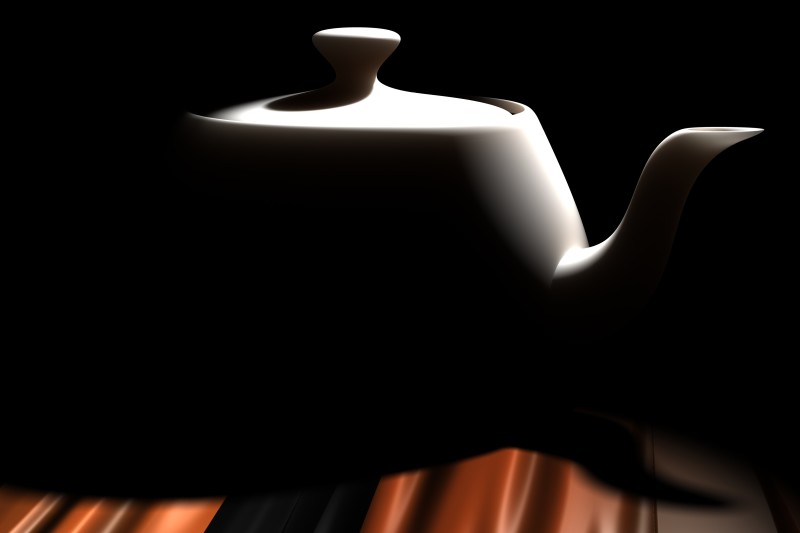
This scene is completely synthetic it contains no photographs or scans,
only 3D models and mathematicak methods. The big version, which I've
rendered for a printed photograph of 75x50 cm, took an hour and a half
or more on the server for a 3500x2500 or so resolution. And it looks
great in print. The large (printed) version is not freely available.
The shadows and refection are not of POVray level of complexity: using
the graphics card (which on the server is a moderate NVidia 6200) as
co-processor, complicated shadws and lighting and also material effects
are possible, like I've used a plastic surface for the pot, too, which
is responsible for translucency. And the accuracy can be higher because
the graphics hardware accerates the computations, while Gelato is
internally build to serve for instance the movie industry.
This (free) version should but due to a bug doesn't yet support more
than 8 bits/channel, which would be even better for high quality (good
contrast) prints.
A well known Open Source 3D program is Blender, which can also do
radiosity, and converts file formats, and in principle appears to be
able to use gelato using a python script:
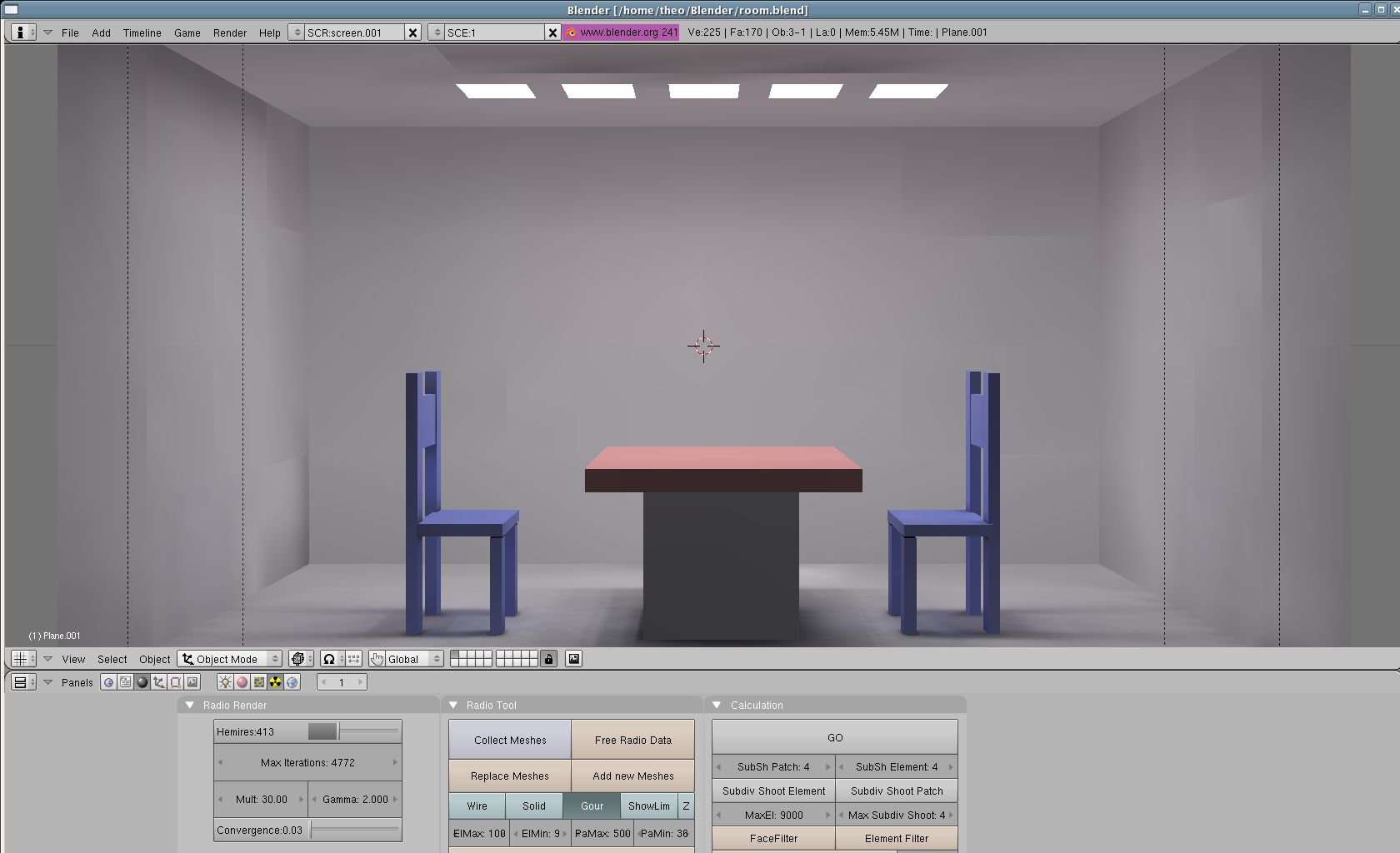
The above runs on Linux (on a big screen) and is interactive: the image
updates while computations progress, and the view can be transformed,
that is one can move htrough the scene in real time, with the right
(I've the latest installed) NVidia driver, that works good on Linux.
There are imperfections in the above rendering, because I'm trying out
their parameters, the example looks nice, but in standard settings
produces a bit of a trick result, which looks good because of the light
simulation outcome appening to look good at a certain point.
Another graphics program I looked into is from a person who works for
Sony in California, and spends free time to make great software freely
available:
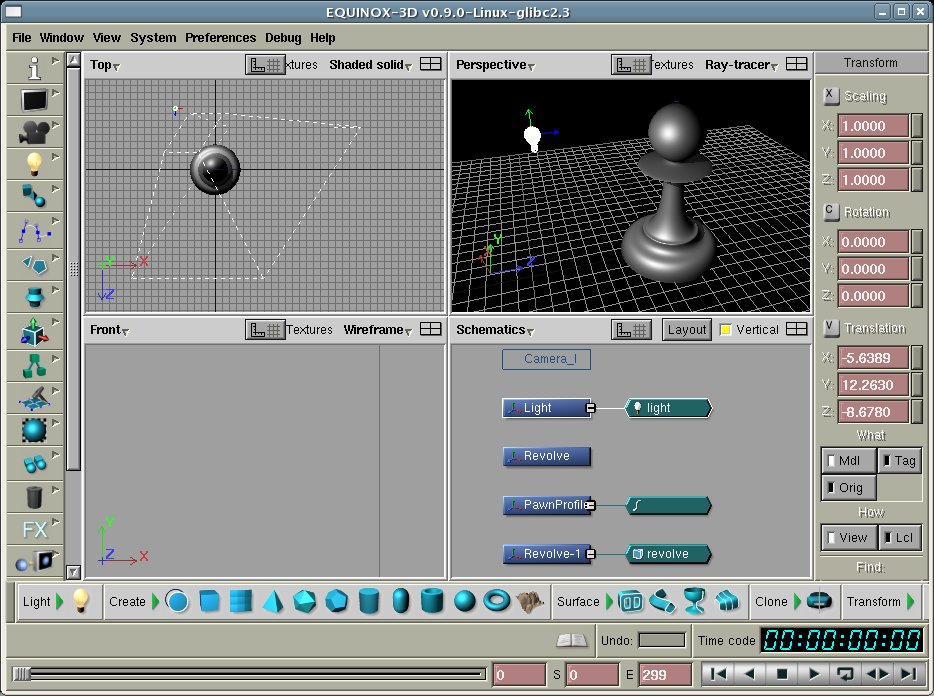
Its a pity that the examples from the example page are not
downloadable, they look very cool!
See al list of Open Source graphics programs here.
Japanese fighter robots
Will the american-like wrestler win ?
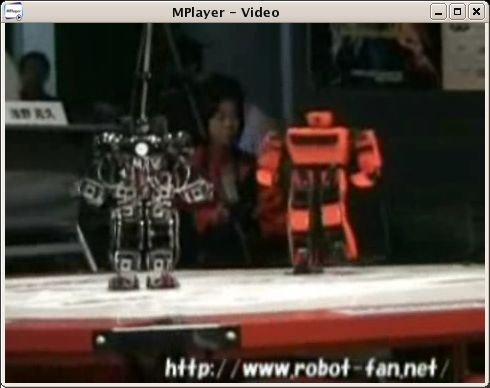
All kinds of performers on stagein the "De Badkuip", but only one
audience member in te beginning (except for personel): me.. :
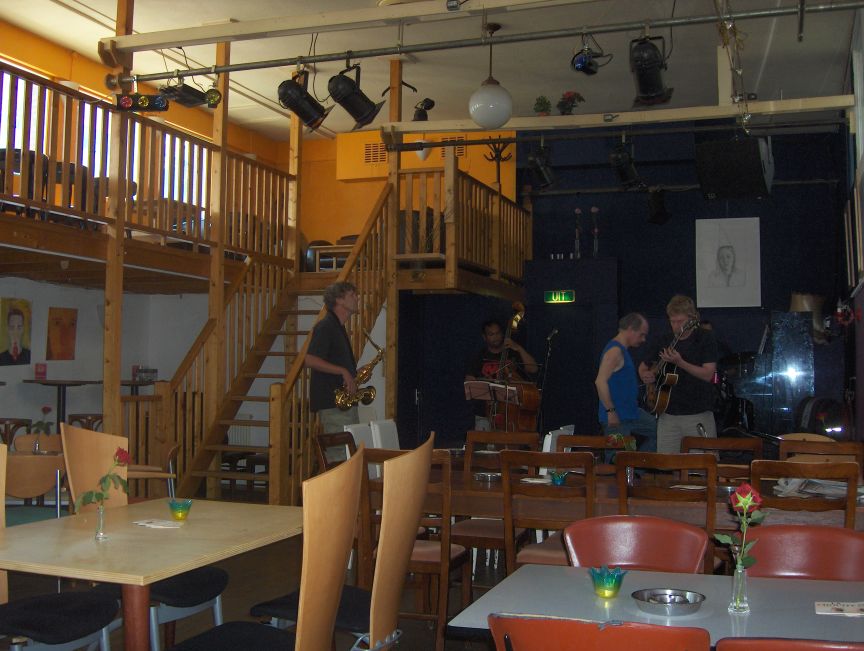
From the table, respectively with and without flash:

great, a good rose

Racemonsters? Well, 3 went against the right side, having a plan, I'm
sure. These cars are built also with safety in mind. A great picture
from the indy which was live on dutch tv whih is great. With mpeg-4
transcoding a bit of the race feel is visible at times, through all
kinds of optimizers and mpeg and tv channel signal tricks, in this
still even a bit of the very high speed and great race track feelings
comes through:
